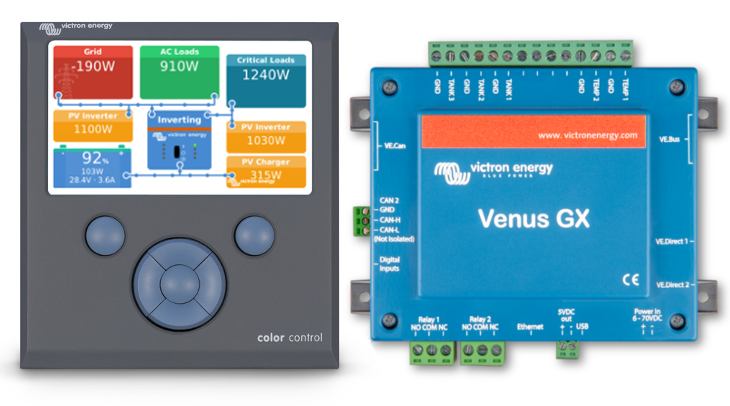
Today we have released a new version of Venus OS – the software which controls the Color Control GX, Venus GX and Octo GX.
The highlights in v2.20 are the addition of Scheduled Charging for ESS systems, addition of the GX GSM, and a Start equalize button: no more toggling of the rocker switch back and forth on Multis and Quattros.
Scheduled charging
The features allows up to five schedules, during which the system will take power from the grid to charge the battery. Typically used to charge the battery during off-peak tariff time windows. For each schedule, configure a start-time, duration, and optionally set the percentage up to which you want the battery to be charged:
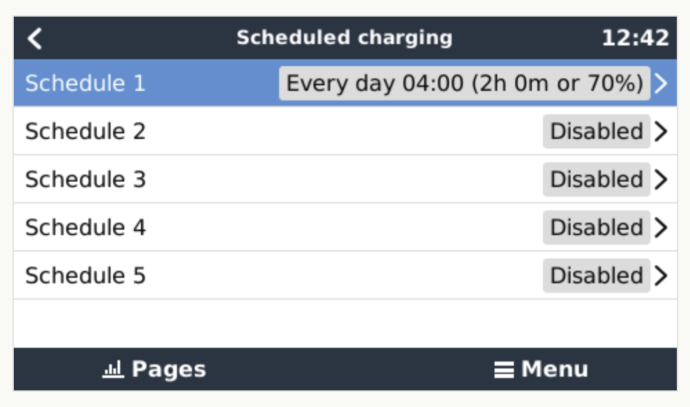
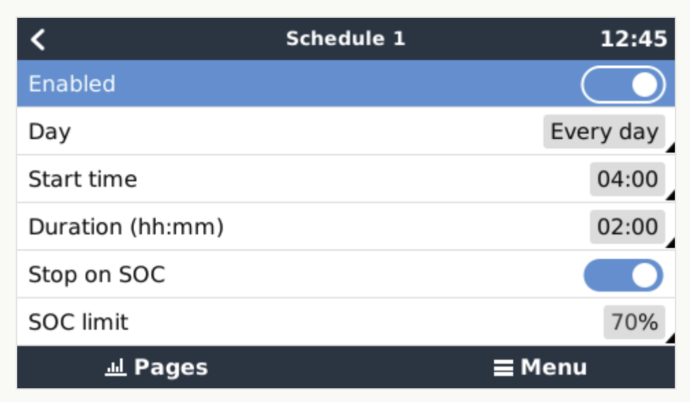
Full change log
General:
- Add support for the GX GSM; a 3G cellular modem accessory for Venus-OS devices; This is a new product, expected to be in stock in a few weeks.
- Add Start Equalisation button to the Multi/Quattro menu. See Device List -> Multi or Quattro -> Advanced. In this same change we have re-ordered the menus at the bottom of the VE.Bus page. Note that this only works for VE.Bus firmware version 400 and newer. Finally, no more flipping the rocker switch back and forth on the Multis & Quattros.
ESS:
- Add scheduled charging. Configure up to 5 schedules during which the system will take power from the grid to charge the battery during off-peak tariff time windows.
- Increase maximum grid setpoint from 100kW to 1MW.
- ESS Systems with a grid meter, Fronius Inverters and Zero Feed-in enabled: no longer shut the PV Inverters down when there is a power failure. Instead; let the Multi/Quattro regulate them with frequency shifting. Thanks to Eon F. for reporting.
- ESS with DVCC enabled: fix a bug that prevented the Multi to discharge in some very specific conditions. Only seen with Lynx Ion battery systems. Introduced when launching DVCC, v2.12.
DVCC:
- Improve (= reduce) LG and Pylontech max working voltage for DVCC enabled systems to eliminate over-voltage errors. LG: change from 57.5V to 57.3V, Pylontech: change from 53.2V to 52V
- Add shared temperature sense, and a switch (default on) for the feature. At present only a single configuration is supported: a BMV-702 or 712 with the temperature sensor accessory. When such a battery monitor is connected, and temperature sense is enabled, the Venus-device will send the battery temperature to the connected Solar Chargers and Inverter/chargers.
- Always show the Max Charge Current setting in the System Setup menu so it can also be used when there is no inverter/charger in the system.
- Sony/Murata: fix issue that occurred in off-grid three-phase systems with PV Inverters: the PV Inverters were throttled too much, causing the load to be powered from the battery instead of from the sun. Thank you Hubert D. for helping with this.
ESS Auto-recharge (a feature introduced in v2.12 as a DVCC only feature):
- This feature now also works when DVCC is not enabled.
- Simplify the logic for starting an auto-recharge: start only when SOC <= minSOC – 5%, which
- Fixes auto-recharge not starting when BatteryLife-setting was disabled and minSOC set to 5% (0% wasn’t far enough below 5% to activate).
- Removes the ‘feature’ that would always start an auto-recharge when the BatteryLife-setting was enabled and SOC <= 0%.
- Thank you to Simon Hackett for reporting & getting to the bottom of this.
GUI:
- Add WiFi and GSM GX status icons to the status bar:
- WiFi icon is only visible when WiFi is used to connect to internet.
- 3G/Edge/etc. icon only visible when modem is used to connect to internet.
- Modem signal strength icon is visible when there is a modem.
- Change the layout of the on/off & yes/no switch: no more text in the switch; more versatile and less translation issues.
- Reword several ESS-related menu items (remove the double negatives)
- Only show the SOC as reported by the inverter/charger when its actually enabled and configured in VEConfigure.
- Add notification to user that a VE.Bus system requires a reset after disabling DVCC. Not doing so will make the system go into pass-through after a while.
CCGX Only:
- Fix display not working and backlight making noise on some units. (thank you to various people alerting us)
- Fix display brightness setting issue. Note that this might, only one time, increase the backlight setting on a CCGX during the update.
ModbusTCP:
- Fix bug that caused stale values to be returned for disconnected devices. Instead of returning the last value, it will now return the error that means device not found: 0x0A – GatewayPathUnavailable.
Other:
- Always connect to WiFi (when configured). Instead of only connecting to WiFi when ethernet is not plugged in.
- Add the “Hjelmslund Electronics USB to RS485 Iso converter” as a supported RS485 interface
- Add support for the Fiamm FzSonick batteries (connected via RS485)
- Change the demo mode data to ESS
- Add support for Murata batteries, and rename Sony batteries to Murata.
- Fix error in VRM Remote Firmware update mechanism when a “NMEA 2000<->0183 Gateway (NGW-1)” device was connected to the canbus. Thank you Charles P. for reporting it.
Developer related:
- Add websockets to MQTT. This is on port 9001, there Mosquitto is running as a broker on Venus, see here for example usage: https://github.com/victronenergy/venus-html5-app
- Raspberrypis: update bootloader to v1.20180417, fixing issues with recent Raspberrypi2 hardware
- Raspberrypis: add device tree overlay for waveshare/ft5406 LCD screen
- Venus GX: update the Linux kernel from 4.1.44 to 4.9.113
- Enable netfilter / iptables in the kernel config for all machines
- Debian packages: drop wheezy packages
- Update build environment (OE) from Jethro to Rocko, and also update Linux kernels for various machines
- Serial-starter mechanics have been reworked, see /etc/venus/serial-start.conf
- Add driver for the Bornay WindPlus MPPT. No GUI or VRM integrations yet.
Thank you
My gratitude to Simon H.; Hubert D.; Charles P.; Eon F.; and others for flagging-up and even contributing changes in the source code to help fix these and a number of other issues.
Enjoy & how to update
These are all that is in version v2.20. You can find information about how to install this the new version of Venus OS here. For the full change log, visit Victron Professional.
Have a good day!
Matthijs Vader
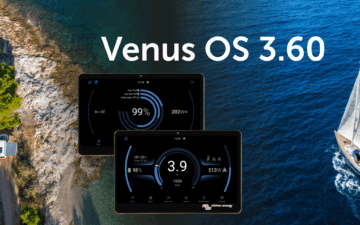
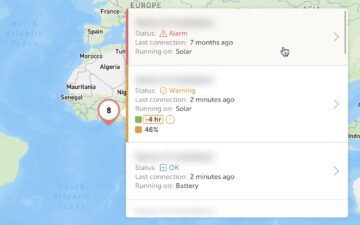










 #victronenergy #adventure
#victronenergy #adventure
 ELECTRICS
ELECTRICS 
